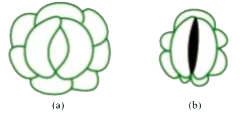Tracheids are primitive vascular elements and
(a) Are rarely found in pteridophytes
(b) Are dead cells at maturity
(c ) Have thickened lighnified walls with simple pits
All are correct
Only (b) is correct
Both (a) and (b) are incorrect
Both (a) and (c ) are correct
The correct Answer is:2
Step by step video, text & image solution for Tracheids are primitive vascular elements and (a) Are rarely found in pteridophytes (b) Are dead cells at maturity (c ) Have thickened lighnified walls with simple pits by Biology experts to help you in doubts & scoring excellent marks in Class 12 exams.
Similar Questions
Which simple permanent tissue consists of long narrow cells with thick and lignified walls having a few or numerous pits
View SolutionRead the following statements and find out the correct statements.
A. Tracheids are elongated or tube like cells with thin and lignified walls and tapering ends.
B. Vessal elements are interconnected through perforations in their common walls.
C. Xylem fibres are always septate.View Solution
Knowledge Check
- Question 1 - Select One
Which of the following tissues has dead cells with thick and lignified cells walls, having a few or numerous pits?
ASclerenchymaBCollenchymaCPhloemDNone of these - Question 2 - Select One
[A]: Sclerenchyma cells are rarely found in plants.
[R]: Sclerencyma cells are dead but have pro- toplasmAIf both A and R are true and R is the correct explanation of ABIf both A and R are true but R is not the correct explanation of ACIf A is true and R is falseDIf both A and R are false - Question 3 - Select One
Which of the following statements is /are true
(A) Uneven thickening of cell wall is characteristic of sclerenchyma
(B) Periblem forms the cortex of the stem and the root
(C) Tracheids are the chief water transporting elements in gymnosperms
(D)Companion cell is devoid of nucleous at maturity
(E) The Commercial cork is obtained from Quercus suberAA and D onlyBB and E onlyCC and D onlyDB, C and E only
Give reasons for the following:
a. Very small animals are rarely found in polar regions.
b. Mammals from colder climate generally have shorter ear and limbs.
c. Initially we feel nausea and fatigue when we reach a high altitude such as Rohtang Pass and then, gradually, we feel normal.View SolutionIdentify the tissue which shows the following features :
(a) All the cells are of one type
(b) The cells are living and have thin cellulose wall
(c) The cells have prominent nuclei and very few vacuoles
(d) The cells divide regularlyView SolutionObserve the diagram and answer the following :

(a) Which of these guard cells show a higher water content, A or B ?
(b)Are these types of guard cells found in monocots or dicots ?
(c) Name the element which play an important role in the opening and closing of stomata.View SolutionAtoms of eight elements A, B, C, D, E, F, G and H have the same number of electronic shells but different number of electrons in their outermost shell. It was found that elements A and G combine to form an ionic compound which can also be extracted from sea water. This compound is added in a small amount to almost all vegetable dishes during cooking. Oxides of elements A and B are basic in nature while those of E and Fare acidic. The oxide of D is almost neutral. Based on the above information, answer the following questions:
(i) To which group or period of the periodic table do the listed elements belong? (ii) What would be the nature of compounds formed by a combination of elements B and F? (iii) Which two of these elements could definitely be metals and which are likely to be non-metals? (iv) Which one of the eight elements is most likely to be found in gaseous state at room temperature? (v) If the number of electrons in the outermost shell of elements C and G be 3 and 7 respectively, write the formula of the compound formed by the combination of C and G. (vi) Which one of the eight elements is likely to be a noble gas? (vii) Which one of the eight elements would have the largest atomic radius? (viii) Which one of these eight elements is likely to be a semi-metal or metalloid?View SolutionCells of tracheary elements (tracheids and vessels) become dead at maturity and lose their protoplasm due to the deposition of lignocellulosic cell wall thickenings. This is an example of
View Solution

